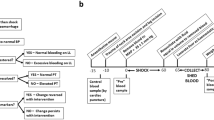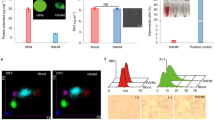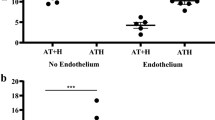Abstract
Heparin cofactor II (HCII) is a critical anticoagulant protein that inactivates thrombin. In our previous mouse studies, we demonstrated that GalNAc-HCII, a small interfering RNA (siRNA) targeting HCII conjugated with N-acetylgalactosamine (GalNAc), exhibited promising therapeutic effects in hemophilia A mouse models. Further evaluation in large animal models, especially with FVIII inhibitors, is essential before GalNAc-HCII can proceed to clinical trials. In this study, we successfully established, for the first time, an acquired hemophilia A canine model by multiple intravenous injections of a rabbit-dog chimeric neutralizing anti-canine FVIII antibody. In the control group, the Beagle dogs exhibited spontaneous bleeding symptoms accompanied by prolonged activated partial thromboplastin time (APTT). After administration, GalNAc-HCII (0.8 and 1.6 mg/kg) demonstrated potent, dose-dependent, and durable HCII inhibitory effects. After 5 days, in normal dogs, GalNAc-HCII reduced HCII levels to 32.67% ± 3.07% and 10.62% ± 1.74% with 0.8 and 1.6 mg/kg GalNAc-HCII, respectively. In hemophilic dogs, GalNAc-HCII treatment significantly improved hemostatic function. Specifically, in the carotid artery thrombosis model, the thrombus formation time was shortened [29.7 ± 2.08 min (0.8 mg/kg) and 18.0 ± 1.0 min (1.6 mg/kg) vs. 40 min (control), P < 0.01]; in the knee joint puncture-induced bleeding model, joint bleeding and synovitis were alleviated; and in the saphenous vein bleeding model, the number of hemostatic events increased. Furthermore, repeated administration of GalNAc-HCII effectively reduced the prolonged APTT. This study demonstrates the efficacy of GalNAc-HCII in hemophilic dogs, suggesting it as a promising novel therapeutic option for patients with hemophilia, including those with FVIII inhibitors.
This is a preview of subscription content, access via your institution
Access options
Subscribe to this journal
Receive 6 print issues and online access
$259.00 per year
only $43.17 per issue
Buy this article
- Purchase on SpringerLink
- Instant access to full article PDF
Prices may be subject to local taxes which are calculated during checkout








Similar content being viewed by others
Data availability
The datasets generated during and/or analyzed during the current study are available from the corresponding author on reasonable request.
References
Peyvandi F, Garagiola I, Young G. The past and future of haemophilia: diagnosis, treatments, and its complications. Lancet. 2016;388:187–97.
Castaman G, Matino D. Hemophilia A and B: molecular and clinical similarities and differences. Haematologica. 2019;104:1702–9.
Song X, Zhong J, Xue F, Chen L, Li H, Yuan D, et al. An overview of patients with haemophilia A in China: epidemiology, disease severity and treatment strategies. Haemophilia. 2021;27:e51–e59.
Escuriola Ettingshausen C, Yang R, Wu W, Meeks SL. Inhibitors: diagnostic challenges, unknowns of inhibitor development, treatment of bleeding and surgery, and insights into diagnosis and treatment in China. Haemophilia. 2022;28:111–118.
Hay CR, DiMichele DM. International Immune Tolerance Study. The principal results of the International Immune Tolerance Study: a randomized dose comparison. Blood. 2012;119:1335–44.
Rezende SM, Neumann I, Angchaisuksiri P, Awodu O, Boban A, Cuker A, et al. International Society on Thrombosis and Haemostasis clinical practice guideline for treatment of congenital hemophilia A and B based on the Grading of Recommendations Assessment, Development, and Evaluation methodology. J Thromb Haemost. 2024;22:2629–52.
Swystun LL, Lillicrap D. Gene therapy for coagulation disorders. Circ Res. 2016;118:1443–52.
Reiss UM, Zhang L, Ohmori T. Hemophilia gene therapy-new country initiatives. Haemophilia. 2021;27:132–141.
Deshpande SR, Joseph K, Tong J, Chen Y, Pishko A, Cuker A. Adeno-associated virus-based gene therapy for hemophilia A and B: a systematic review and meta-analysis. Blood Adv. 2024;8:5957–74.
Yada K, Nogami K. Novel insights and new developments regarding coagulation revealed by studies of the anti-factor IXa (Activated Factor IX)/Factor X bispecific antibody, emicizumab. Arterioscler Thromb Vasc Biol. 2020;40:1148–54.
Xu Y, Wang Y, Wu R, Zheng C, Zhang L, Xu W, et al. Reduced doses of emicizumab achieve good efficacy: results from a national-wide multicentre real-world study in China. Haemophilia. 2024;30:959–69.
Young G, Srivastava A, Kavakli K, Ross C, Sathar J, You CW, et al. Efficacy and safety of fitusiran prophylaxis in people with haemophilia A or haemophilia B with inhibitors (ATLAS-INH): a multicentre, open-label, randomised phase 3 trial. Lancet. 2023;401:1427–37.
Young G, Lenting PJ, Croteau SE, Nolan B, Srivastava A. Antithrombin lowering in hemophilia: a closer look at fitusiran. Res Pr Thromb Haemost. 2023;7:100179.
Prince R, Bologna L, Manetti M, Melchiorre D, Rosa I, Dewarrat N, et al. Targeting anticoagulant protein S to improve hemostasis in hemophilia. Blood. 2018;131:1360–71.
Polderdijk SG, Adams TE, Ivanciu L, Camire RM, Baglin TP, Huntington JA. Design and characterization of an APC-specific serpin for the treatment of hemophilia. Blood. 2017;129:105–13.
Griffith MJ, Noyes CM, Tyndall JA, Church FC. Structural evidence for leucine at the reactive site of heparin cofactor II. Biochemistry. 1985;24:6777–82.
Tran TH, Marbet GA, Duckert F. Association of hereditary heparin co-factor II deficiency with thrombosis. Lancet. 1985;2:413–4.
Sie P, Dupouy D, Pichon J, Boneu B. Constitutional heparin co-factor II deficiency associated with recurrent thrombosis. Lancet. 1985;2:414–6.
Lopaciuk S, Bykowska K, Kopeć M. Prevalence of heparin cofactor II deficiency in patients with a history of venous thrombosis. Pol J Pharm. 1996;48:109–11.
Ragni MV, Chan SY. Innovations in RNA therapy for hemophilia. Blood. 2023;142:1613–21.
Tollefsen DM. Heparin cofactor II deficiency. Arch Pathol Lab Med. 2002;126:1394–1400.
Villa P, Aznar J, Vaya A, España F, Ferrando F, Mira Y, et al. Hereditary homozygous heparin cofactor II deficiency and the risk of developing venous thrombosis. Thromb Haemost. 1999;82:1011–4.
Bernardi F, Legnani C, Micheletti F, Lunghi B, Ferraresi P, Palareti G, et al. A heparin cofactor II mutation (HCII Rimini) combined with factor V Leiden or type I protein C deficiency in two unrelated thrombophilic subjects. Thromb Haemost. 1996;76:505–9.
He L, Vicente CP, Westrick RJ, Eitzman DT, Tollefsen DM. Heparin cofactor II inhibits arterial thrombosis after endothelial injury. J Clin Investig. 2002;109:213–9.
Lin WY, Zhu R, Zhang Z, Lu X, Wang H, He W, et al. RNAi targeting heparin cofactor II promotes hemostasis in hemophilia A. Mol Ther Nucleic Acids. 2021;24:658–68.
Dargaud Y, Béguin S, Lienhart A, Al Dieri R, Trzeciak C, Bordet JC, et al. Evaluation of thrombin generating capacity in plasma from patients with haemophilia A and B. Thromb Haemost. 2005;93:475–80.
Muto A, Yoshihashi K, Takeda M, Kitazawa T, Soeda T, Igawa T, et al. Anti-factor IXa/X bispecific antibody ACE910 prevents joint bleeds in a long-term primate model of acquired hemophilia A. Blood. 2014;124:3165–71.
Shetty S, Vora S, Kulkarni B, Mota L, Vijapurkar M, Quadros L, et al. Contribution of natural anticoagulant and fibrinolytic factors in modulating the clinical severity of haemophilia patients. Br J Haematol. 2007;138:541–4.
Dargaud Y, Meunier S, Negrier C. Haemophilia and thrombophilia: an unexpected association! Haemophilia. 2004;10:319–26.
Nguyen GN, Everett JK, Kafle S, Roche AM, Raymond HE, Leiby J, et al. A long-term study of AAV gene therapy in dogs with hemophilia A identifies clonal expansions of transduced liver cells. Nat Biotechnol. 2021;39:47–55.
Rawle FE, Lillicrap D. Preclinical animal models for hemophilia gene therapy: predictive value and limitations. Semin Thromb Hemost. 2004;30:205–13.
Franchini M, Targher G, Montagnana M, Lippi G. Laboratory, clinical and therapeutic aspects of acquired hemophilia A. Clin Chim Acta. 2008;395:14–18.
Xue F, Wang P, Yuan Z, Shi C, Fang Y, Liu W, et al. Total knee arthroplasty after gene therapy for hemophilia B. N Engl J Med. 2022;387:1622–4.
Manco-Johnson MJ, Abshire TC, Shapiro AD, Riske B, Hacker MR, Kilcoyne R, et al. Prophylaxis versus episodic treatment to prevent joint disease in boys with severe hemophilia. N Engl J Med. 2007;357:535–44.
Collins PW. Personalized prophylaxis. Haemophilia. 2012;18:131–135.
Den Uijl IE, Mauser Bunschoten EP, Roosendaal G, Schutgens RE, Biesma DH, Grobbee DE, et al. Clinical severity of haemophilia A: does the classification of the 1950s still stand? Haemophilia. 2011;17:849–53.
Martinez MN, Mochel JP, Neuhoff S, Pade D. Comparison of canine and human physiological factors: understanding interspecies differences that impact drug pharmacokinetics. AAPS J. 2021;23:59.
Siner JI, Iacobelli NP, Sabatino DE, Ivanciu L, Zhou S, Poncz M, et al. Minimal modification in the factor VIII B-domain sequence ameliorates the murine hemophilia A phenotype. Blood. 2013;121:4396–403.
Wang Q, Dong B, Firrman J, Wu W, Roberts S, Moore AR, et al. Evaluation of the biological differences of canine and human factor VIII in gene delivery: implications in human hemophilia treatment. Gene Ther. 2016;23:597–605.
Funding
This work was supported by the National Natural Science Foundation of China (Nos. 82170131 and 82470134), the Chang Jiang Scholars Program (No. 2022161), the Young Top-notch Talent Cultivation Program of Hubei Province 202117, and the National Key R&D Program of China (Nos. 2022YFC2304600 and 2023YFC2509500).
Author information
Authors and Affiliations
Contributions
LT and YH conceived and designed the study. YZ, HK, and TL collected and assembled the data. YZ, HW, HK, and LT analyzed and verified the data. YZ, LT, HK, and YH verified and interpreted the data. All authors wrote and approved of the article and are accountable for publication.
Corresponding author
Ethics declarations
Competing interests
The authors declare no competing interests.
Ethical approval and consent to participate
We have received informed consent from all subjects. This study was reviewed and approved by the Medical Ethical Committee and the Animal Ethics Committee of Union Hospital, Huazhong University of Science and Technology. [2024] IACUC Number: 4357. All methods were performed in accordance with the relevant guidelines and regulations.
Additional information
Publisher’s note Springer Nature remains neutral with regard to jurisdictional claims in published maps and institutional affiliations.
Supplementary information
Rights and permissions
Springer Nature or its licensor (e.g. a society or other partner) holds exclusive rights to this article under a publishing agreement with the author(s) or other rightsholder(s); author self-archiving of the accepted manuscript version of this article is solely governed by the terms of such publishing agreement and applicable law.
About this article
Cite this article
Zhang, Y., Liu, T., Kou, H. et al. RNAi targeting heparin cofactor II promotes hemostasis in a canine model of acquired hemophilia A. Gene Ther 32, 398–409 (2025). https://doi.org/10.1038/s41434-025-00541-w
Received:
Revised:
Accepted:
Published:
Issue date:
DOI: https://doi.org/10.1038/s41434-025-00541-w



